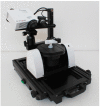Wear Distribution Detection of Knee Joint Prostheses by Means of 3D Optical Scanners
- PMID: 28772725
- PMCID: PMC5506914
- DOI: 10.3390/ma10040364
Wear Distribution Detection of Knee Joint Prostheses by Means of 3D Optical Scanners
Abstract
The objective of this study was to examine total knee polyethylene inserts from in vitro simulation to evaluate and display-using a 3D optical scanner-wear patterns and wear rates of inserts exposed to wear by means of simulators. Various sets of tibial inserts have been reconstructed by using optical scanners. With this in mind, the wear behavior of fixed and mobile bearing polyethylene knee configurations was investigated using a knee wear joint simulator. After the completion of the wear test, the polyethylene menisci were analyzed by an innovative 3D optical scanners in order to evaluate the 3D wear distribution on the prosthesis surface. This study implemented a new procedure for evaluating polyethylene bearings of joint prostheses obtained after in vitro wear tests and the proposed new approach allowed quantification of the contact zone on the geometry of total knee prostheses. The results of the present study showed that mobile TKPs (total knee prosthesis) have lower wear resistance with respect to fixed TKPs.
Keywords: 3D scanners; 3D wear map; knee joint; prostheses design; wear inspection.
Conflict of interest statement
The authors declare no conflict of interest.
Figures







Similar articles
-
Knee Wear Assessment: 3D Scanners Used as a Consolidated Procedure.Materials (Basel). 2020 May 20;13(10):2349. doi: 10.3390/ma13102349. Materials (Basel). 2020. PMID: 32443746 Free PMC article.
-
Wear analysis of unicondylar mobile bearing and fixed bearing knee systems: a knee simulator study.Acta Biomater. 2011 Feb;7(2):710-5. doi: 10.1016/j.actbio.2010.09.031. Epub 2010 Sep 29. Acta Biomater. 2011. PMID: 20883831
-
Wear of contemporary total knee replacements--a knee simulator study of six current designs.Clin Biomech (Bristol). 2009 Aug;24(7):583-8. doi: 10.1016/j.clinbiomech.2009.04.007. Epub 2009 May 17. Clin Biomech (Bristol). 2009. PMID: 19450910
-
Mobile or fixed unicompartmental knee prostheses? In-vitro wear assessments to solve this dilemma.J Mech Behav Biomed Mater. 2011 Nov;4(8):1936-46. doi: 10.1016/j.jmbbm.2011.06.010. Epub 2011 Jun 26. J Mech Behav Biomed Mater. 2011. PMID: 22098892
-
Fixed versus mobile bearing knee arthroplasty: a review of kinematics and results.J Long Term Eff Med Implants. 2011;21(3):197-203. doi: 10.1615/jlongtermeffmedimplants.v21.i3.30. J Long Term Eff Med Implants. 2011. PMID: 22150352 Review.
Cited by
-
Wear and performance of a tripolar total hip replacement.Ann Jt. 2022 Jul 15;7:23. doi: 10.21037/aoj-21-7. eCollection 2022. Ann Jt. 2022. PMID: 38529131 Free PMC article.
-
Development of a Three-Dimensional Optical Verification Technology without Environmental Pollution for Metal Components with Different Surface Properties.Materials (Basel). 2022 Sep 4;15(17):6139. doi: 10.3390/ma15176139. Materials (Basel). 2022. PMID: 36079520 Free PMC article.
-
Linear and Volumetric Polyethylene Wear Patterns after Primary Cruciate-Retaining Total Knee Arthroplasty Failure: An Analysis Using Optical Scanning and Computer-Aided Design Models.Materials (Basel). 2024 Oct 13;17(20):5007. doi: 10.3390/ma17205007. Materials (Basel). 2024. PMID: 39459713 Free PMC article.
-
Quantifying wear depth in hip prostheses using a 3D optical scanner.Wear. 2018 Jan 15;394-395:195-202. doi: 10.1016/j.wear.2017.10.008. Epub 2017 Oct 16. Wear. 2018. PMID: 30220743 Free PMC article.
-
In vitro method to quantify and visualize mechanical wear in human meniscus subjected to joint loading.J Mech Behav Biomed Mater. 2022 Sep;133:105338. doi: 10.1016/j.jmbbm.2022.105338. Epub 2022 Jun 28. J Mech Behav Biomed Mater. 2022. PMID: 35834895 Free PMC article.
References
-
- Bills P., Blunt L., Jiang X. Development of a technique for accurately determining clinical wear in explanted total hip replacements. Wear. 2007;263:1133–1137. doi: 10.1016/j.wear.2007.01.054. - DOI
-
- Carmignato S., Balcon M., Zanini F. Investigation on the Accuracy of CT Measurements for Wear Testing of Prosthetic Joint Components; Proceedings of the 5th Conference on Industrial Computed Tomography (iCT) 2014; Wels, Austria. 25–28 February 2014.
LinkOut - more resources
Full Text Sources
Other Literature Sources

